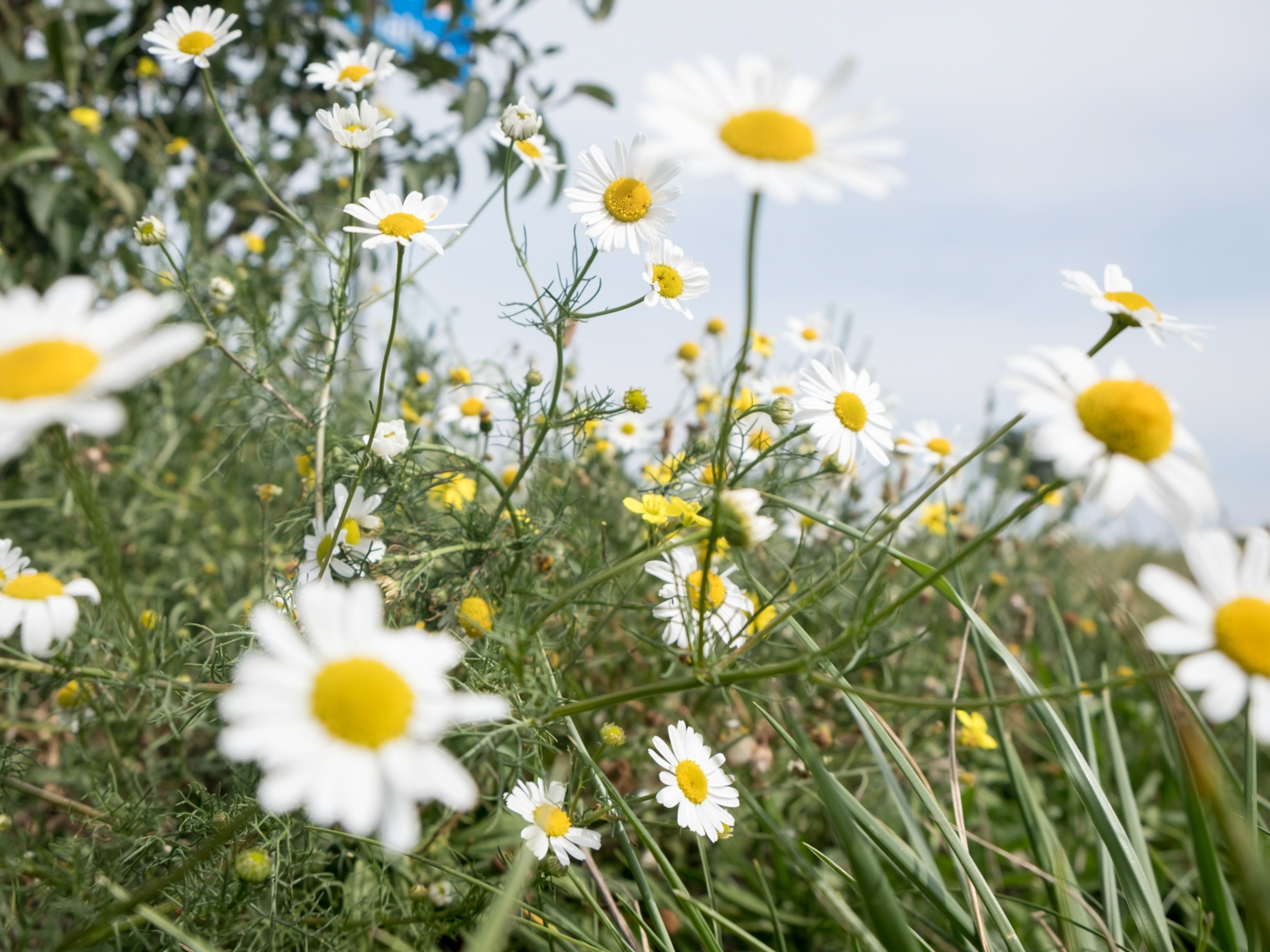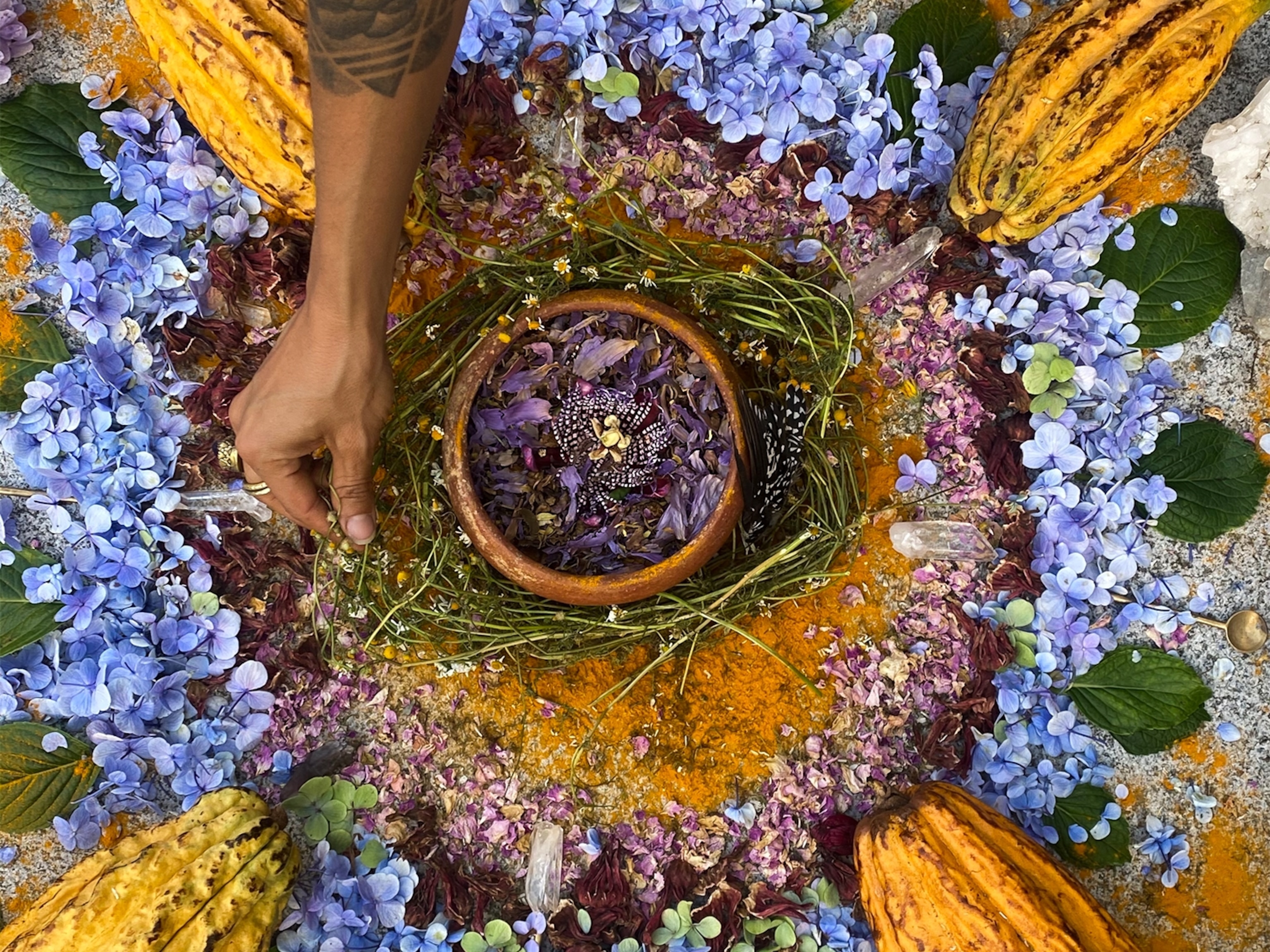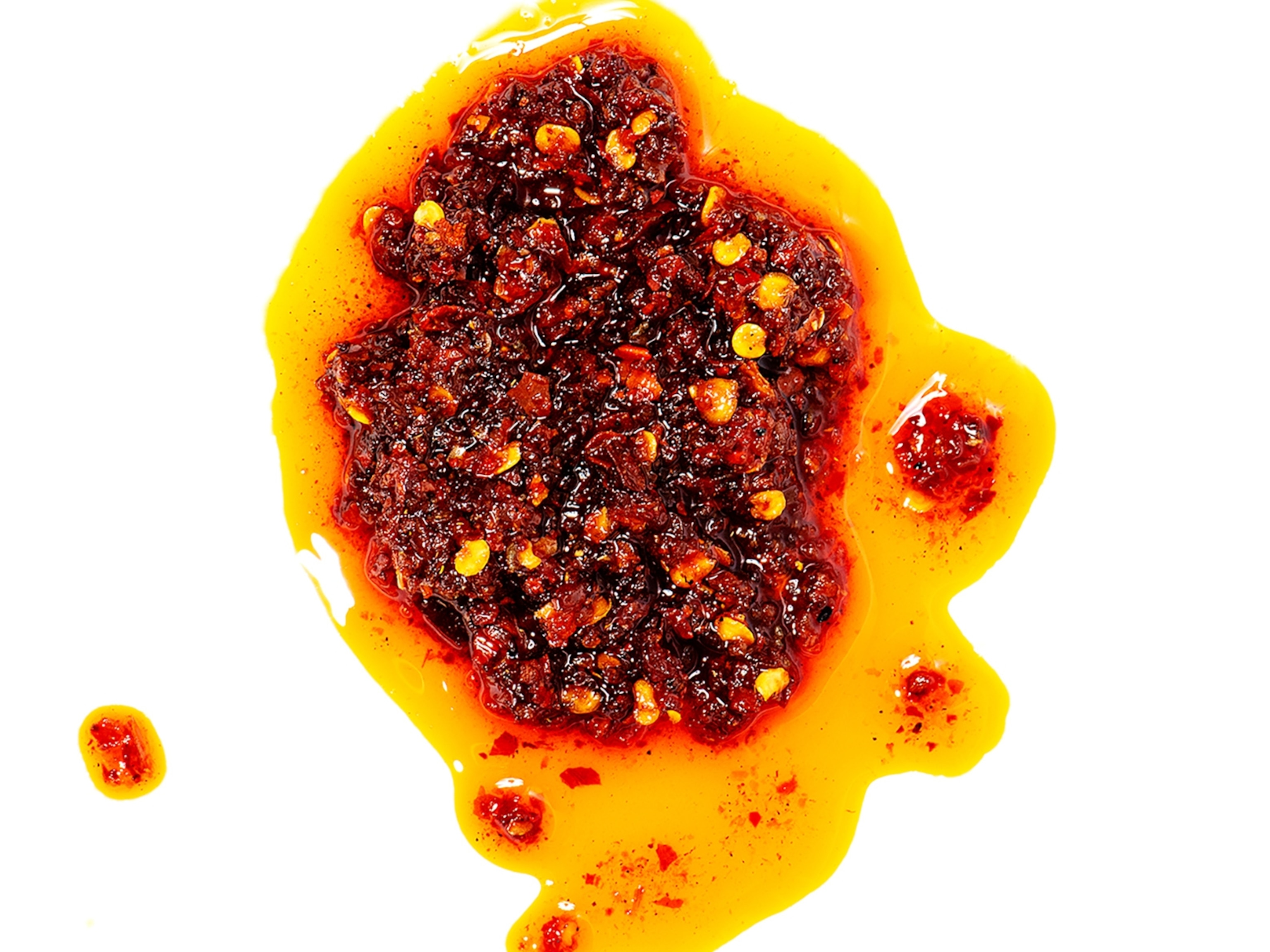A stranger with an air rifle appeared out of nowhere in the mountain valley where Lang and I were standing. This should be interesting, I thought.
“Hi. We’re lost,” said Lang, who wore a handwoven traditional blouse over her spandex trousers and rubber boots. “Have you seen my relatives? Seven men and two women?”
To get here, we’d spent a day riding motorbikes over a bumpy mountain pass, fording knee-high rivers, winding our way up switchbacks, and even sidestepping a poisonous snake. Now we were close to our destination—a black cardamom forest on a nearby peak—but couldn’t find the approach trail among the shrubs and wildflowers. Lang’s husband, Duong, had just wandered off to look for it.
As it turned out, Lang and the hunter were from the same village, not far from Hoang Lien National Park. He had been farming cardamom in the park for years, he said, and knew exactly where her family was camped.
We had entered the park, a collection of rugged mountains and valleys near Vietnam’s border with China, to see cardamom being harvested in the wild. Giang Thi Lang and Nguyen Danh Duong are trekking guides in the nearby town of Sa Pa; I had befriended them years earlier while living in Hanoi, the Vietnamese capital. Lang’s family has cultivated cardamom in the Hoang Lien Mountains since the 1990s, and now her younger brother, Cho, who leads the family’s annual harvesting expedition, had agreed to let me tag along.
Even in a country with exceptional biodiversity and natural beauty, Sa Pa stands out. The mountain town sits beside Vietnam’s highest peak, Fansipan (10,312 feet), and on the doorstep of a national park that’s more than twice the size of San Francisco. It’s a great place to hike and to experience the customs of the ethnic-minority groups who have lived in Sa Pa and an adjacent river valley for generations.




The trip was both a grand adventure and a lesson in Vietnam’s recent environmental history. Black cardamom was first planted in the Hoang Lien Mountains in the 1990s as a replacement for opium, a banned crop that once helped prop up Indochina’s colonial economy. The national park, meanwhile, is a symbol of postwar Vietnam’s efforts to protect plant biodiversity. Hence this conundrum: How could a forest be a haven for conservation and cash-crop agriculture at the same time?
Related: See mesmerizing photos of Vietnam from above.
I started my journey in Hanoi, more than 200 miles southeast. At a market near my old apartment, I bought six black cardamom pods for 9,000 Vietnamese dong, or 39 cents. They were about twice as large as their thumbnail-size green cousins, which are used widely in Indian cuisine, and they smelled intensely smoky and fruity—an aromatic cross between a cigar box and a jug of mulled wine.
Black cardamom, known as thao qua, grows along streambeds in high-elevation forests, under the canopy of tall trees. As a dried spice, it is used in pho, Vietnam’s ubiquitous noodle soup, and a few other popular dishes. Trinh Thi Quyen, the vendor who sold me the pods, explained that thao qua’s smoky flavor complements cinnamon and star anise, the other usual members of pho’s spice trifecta.


Thao qua has less of a market in the West than green cardamom: It is primarily sold to Chinese brokers and used in traditional medicine to treat constipation and other ailments. Through the years, rising Chinese demand has made Sa Pa an important hub for black cardamom trading.
That night I rode a northwest-bound train from Hanoi toward the Chinese border. When I arrived in the Vietnamese border city of Lao Cai the next morning, I took an hour-long taxi ride west to Sa Pa, where Lang met me for coffee. She then took me around the corner to a cardamom warehouse, where workers were sorting freshly harvested pods under a bare light bulb.
Business at the warehouse appeared to be booming. Every few minutes a farmer would pull up on a motorbike carrying fertilizer bags stuffed with thao qua. Then the warehouse’s owner, Nguyen Thi Hue, would pay him on the spot from an ostentatiously fat bundle of cash. I saw many thousands of pods waiting to be sorted. A flotilla of small trucks had parked outside, waiting to whisk them to Lao Cai and north across the border.
Hue told us that her thao qua buying price was currently five dollars a kilogram, but that it changed constantly, based on supply and demand. A generation ago, Sa Pa’s spice traders did not have such regular contact with Chinese brokers, she added, glancing at her silver iPhone. “Now it’s much easier: We just call them.”
Sa Pa, once a summer retreat for French colonial officials, sits among terraced rice fields and cloud-draped forests. In Vietnam, such highlands often are farmed not by Vietnamese but by people from some of the country’s 53 officially recognized ethnic minorities. Some of these groups cultivated opium as a cash crop under French rule, and continued even after Vietnam declared its independence in 1945 and fought successive wars—against France, the United States and its allies, and later China, which briefly invaded northern Vietnam in 1979.
Lang’s family is from the Hmong ethnic group and lives in Ta Van, a village outside Sa Pa that has profited in recent years from Sa Pa’s boom in trekking tourism.







But cardamom is still an important source of village income. Lang’s father, Giang, told me that he began cultivating it deep in what is now Hoang Lien National Park in 1994, just after the government ordered him to stop growing the opium he had planted there when the American War ended in 1975. “I used to love going there,” he told me in his living room. “Now I always push my kids to look after it.”
Hoang Lien National Park, established in 2002, is one of many protected areas in Vietnam where ethnic-minority groups earn a living from land that belongs to the state. Enforcing conservation rules with precision in Vietnam’s protected areas is often impossible because so many people with modest incomes live nearby, said Pamela McElwee, author of Forests Are Gold: Trees, People, and Environmental Rule in Vietnam and an associate professor of human ecology at Rutgers University. “It’s just not going to happen, so you have to have some sort of alternate model,” she told me.
McElwee said the “cardamom model”—in which villagers harvest thao qua inside the national park, and park rangers mostly ignore them—has so far worked reasonably well for both sides. Yes, it’s illegal to harvest cardamom within the park’s boundaries, and to collect firewood for campfires that are used to dry it. But cutting down entire forests would be worse, she said, and the Vietnamese authorities often accept such trade-offs, at least for now.
Cardamom farmers still face risks, however. The crop’s rising value has prompted some villagers to steal their neighbors’ harvests, for example, and an uptick in extreme weather in recent years has disrupted the crop’s year-to-year supply. Sarah Turner, a geographer at Canada’s McGill University who studies Vietnam’s black cardamom industry, told me there was a high probability that the recent extreme weather was linked to climate change.
“Now farmers are faced with either trying to find a new cash alternative or basically waiting to see if things might get better,” she said.

Lang’s family is a case in point. Lang and husband Duong, who is from the Muong ethnic group, don’t need cardamom for security, because they run a trekking agency. But Lang’s brother Cho, who never had much interest in being a tour guide, still sees it as a key to his prosperity, despite the financial risks.
The path to Cho’s cardamom wove upward through waist-high brambles that scratched at my bare legs. We were nearing 7,000 feet, having started the day at about half that elevation. Lang, who treks for a living, was visibly winded. But Duong looked nonchalant. “Even if I walked farther, I could still smoke,” he joked, a cigarette hanging rakishly from his mouth.
We arrived at the campsite around sunset and greeted Cho, who had arrived earlier to set it up. I paused to take in the scene. Hundreds of cardamom plants the height of basketball hoops, each with thick, electric green fronds roughly the size and shape of banana leaves, lined a nearby streambed. The fronds seemed to move through the forest in waves, following the stream’s contours, as if they were swirly brushstrokes on a van Gogh canvas.
High above the cardamom stood old trees whose mossy trunks and craggy branches soared hundreds of feet in the air. Some had a shaggy, Seussian look. I wondered how these exquisite specimens had managed to survive here for so long, even as large swaths of northern Vietnam’s forests were logged for timber.
The streamside campsite was basic: a giant blue tarp hoisted on bamboo supports over an earthen bunker that Lang’s father had once hacked out of the mountainside. Inside I saw a campfire and a bed of dried thao qua fronds. This is where the harvesting crew would eat, sleep, and roast black cardamom pods for the next two days.








The site was humming with activity because Cho had recruited nearly a dozen friends, neighbors, and relatives to help shoulder the workload. “We’re cousins,” said one of them, Giang A Thao, when I asked why he’d agreed to do Cho such a big favor. “We help each other.”
The cardamom harvest began early the next morning after a breakfast of rice, instant coffee, and greasy slabs of salted pork that had been cooked on the campfire. The cardamom plot—2,100 plants in all, according to Lang’s father—was split between two gently sloping mountain valleys. Cho divided the group into two teams, and they began scrambling up parallel streambeds. Each farmer carried a machete. The basic idea was to extract raw, red pods from a plant’s base while also clearing nearby vegetation. That way, barring extreme weather events, the plant would have room to grow lots of new pods before next year’s harvest.
For long hours the farmers silently navigated the streambeds, stopping only to drink water and wipe their brows. The air was colder here than in the valley below, and the sun had ducked behind some gathering rain clouds.
By late afternoon they had trudged back to camp and built a fire big enough to roast and smoke a few refrigerator-size mounds of raw cardamom. I watched as a few pods turned from candy-cane red to coffee brown, giving off a heady medicinal smell in the process. Roasting them was essential because it would significantly reduce their weight, making it easier to carry the harvest down the mountain.
The farmers opened a bottle of ruou, the Vietnamese equivalent of moonshine, to celebrate what looked like an impressive haul. There were rounds of shots and more rations of salted pork. We eventually nodded off beside the fire, huddling for warmth as the wind whistled through the cardamom fronds.
I must have fallen into a deep sleep—so deep that I didn’t notice when a heavy rainstorm broke in the wee hours and dumped a bulge of water onto the blue tarp above our heads. By the time I bolted awake around 4 a.m., the campsite was in a panicked frenzy.
Cho’s 350-kilogram cardamom harvest was on track to be worth nearly $2,000 at then current prices, almost as much as Vietnam’s annual median wage. But the bulge, with enough water to fill a Jacuzzi, was sagging directly above the campfire. We worried that the tarp would rip under pressure, flooding the pods beyond repair.
Shouting ensued. Pots and pans clanked. Flashlight beams canvassed the darkness. Cho scrambled up and leaped over the fire, flames licking at his heels, and tried to retie a ripped tarp flap to the tent poles. But the rain kept coming.
By the time the storm tapered off, nearly an hour later, it was almost daylight. The tarp had been further battered and ripped, and many of the people underneath, including me, had been half-soaked in the process. Miraculously, though, the thao qua was dry.
As the sun rose, Duong donned his camouflage jacket and poured out two mugs of coffee. My muscles ached from the hiking and scrambling, and my head was throbbing with a ruou hangover. On our way up this mountain, Duong had been full of energy and bravado. Now he looked chastened.
Once back in Sa Pa, we’d have time for a bowl of steaming pho and a soak in a cardamom-infused herbal bath at a village guesthouse. But before we could relax, we still had a long journey ahead of us, back across the streams and mountain passes we’d traversed on the ascent, this time with the harvesters carrying their precious load.
“Tired?” I asked him, as the sky turned pink.
He nodded.


“Even if they gave me this whole forest, I wouldn’t take it,” he said with a laugh. “This is too hard.”
Travel Wise: Sa Pa, Vietnam
Why go now
Restaurants and hotels have been opening at a brisk pace in Sa Pa, in part because a new highway connecting the nearby city of Lao Cai to Hanoi opened in 2014. But much of the national park that is visible from Sa Pa remains as wild and beautiful as ever.
What to know
Vietnam does not grant visas on arrival to Americans. Apply online or in person at the nearest Vietnamese embassyor consulate.
Getting there
Sa Pa is easily accessible by bus or train from Hanoi. Sleeper bus service takes at least six hours each way, and round-trip tickets cost about $40. Round-trip fares on an overnight sleeper train, eight hours each way, begin at about $50; a private cabin in the train’s luxury sleeper car costs $200 to $400 for two.
Not to miss
- Mount Fansipan
Many Sa Pa–based travel agencies offer multiday trekking tours to Fansipan, Vietnam’s highest mountain and the primary attraction in Hoang Lien National Park. There’s also a cable car from Sa Pa to Fansipan’s peak; a round-trip ticket costs $30. - Village treks
Sa Pa is ringed by ethnic-minority villages, and some are connected to each other by walking or hiking trails. Several trekking companies based in the city offer trip and homestay packages of varying lengths, prices, and difficulty. - Weekend markets
The villages of Can Cau and Bac Ha, both a few hours’ drive from Sa Pa, host weekend markets selling livestock, produce, and more. - Local dishes
In open-air restaurants around Sa Pa Lake, one popular dish is hot pot served with fresh salmon raised in local mountain streams. Another is a plate of crispy, fried river fish called ca suoi.
Go with Nat Geo
Topas Ecolodge
This National Geographic Unique Lodge offers 33 bungalows perched on a hill outside Sa Pa, with dramatic views of peaks and rice terraces.
You May Also Like
Go Further
Animals
- Octopuses have a lot of secrets. Can you guess 8 of them?
- Animals
- Feature
Octopuses have a lot of secrets. Can you guess 8 of them? - This biologist and her rescue dog help protect bears in the AndesThis biologist and her rescue dog help protect bears in the Andes
- An octopus invited this writer into her tank—and her secret worldAn octopus invited this writer into her tank—and her secret world
- Peace-loving bonobos are more aggressive than we thoughtPeace-loving bonobos are more aggressive than we thought
Environment
- Listen to 30 years of climate change transformed into haunting musicListen to 30 years of climate change transformed into haunting music
- This ancient society tried to stop El Niño—with child sacrificeThis ancient society tried to stop El Niño—with child sacrifice
- U.S. plans to clean its drinking water. What does that mean?U.S. plans to clean its drinking water. What does that mean?
- Food systems: supporting the triangle of food security, Video Story
- Paid Content
Food systems: supporting the triangle of food security - Will we ever solve the mystery of the Mima mounds?Will we ever solve the mystery of the Mima mounds?
History & Culture
- Strange clues in a Maya temple reveal a fiery political dramaStrange clues in a Maya temple reveal a fiery political drama
- How technology is revealing secrets in these ancient scrollsHow technology is revealing secrets in these ancient scrolls
- Pilgrimages aren’t just spiritual anymore. They’re a workout.Pilgrimages aren’t just spiritual anymore. They’re a workout.
- This ancient society tried to stop El Niño—with child sacrificeThis ancient society tried to stop El Niño—with child sacrifice
- This ancient cure was just revived in a lab. Does it work?This ancient cure was just revived in a lab. Does it work?
Science
- The unexpected health benefits of Ozempic and MounjaroThe unexpected health benefits of Ozempic and Mounjaro
- Do you have an inner monologue? Here’s what it reveals about you.Do you have an inner monologue? Here’s what it reveals about you.
- Jupiter’s volcanic moon Io has been erupting for billions of yearsJupiter’s volcanic moon Io has been erupting for billions of years
- This 80-foot-long sea monster was the killer whale of its timeThis 80-foot-long sea monster was the killer whale of its time
Travel
- This town is the Alps' first European Capital of CultureThis town is the Alps' first European Capital of Culture
- This royal city lies in the shadow of Kuala LumpurThis royal city lies in the shadow of Kuala Lumpur
- This author tells the story of crypto-trading Mongolian nomadsThis author tells the story of crypto-trading Mongolian nomads








